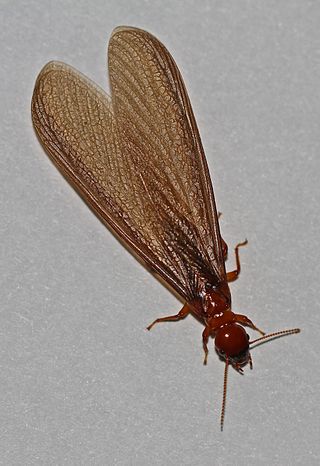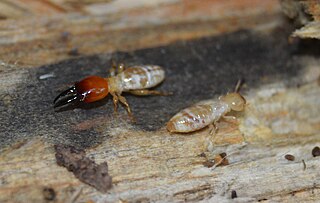
In geography, the temperate climates of Earth occur in the middle latitudes, which span between the tropics and the polar regions of Earth. These zones generally have wider temperature ranges throughout the year and more distinct seasonal changes compared to tropical climates, where such variations are often small and usually only have precipitation changes.

Termites are a group of detritophagous eusocial insects which consume a wide variety of decaying plant material, generally in the form of wood, leaf litter, and soil humus. They are easily identified by the typically soft-bodied and unpigmented worker caste for which they have been colloquially termed "white ants"; however they are not ants to which they are distantly related. About 2,972 extant species are currently described, 2,105 of which are members of the family Termitidae.

The tropics are the regions of Earth surrounding the Equator. They are defined in latitude by the Tropic of Cancer in the Northern Hemisphere at 23°26′10.6″ (or 23.43629°) N and the Tropic of Capricorn in the Southern Hemisphere at 23°26′10.6″ (or 23.43629°) S. The tropics are also referred to as the tropical zone and the torrid zone.

The numbat, also known as the noombat or walpurti, is an insectivorous marsupial. It is diurnal and its diet consists almost exclusively of termites.

Dictyoptera is an insect superorder that includes two extant orders of polyneopterous insects: the order Blattodea and the order Mantodea (mantises). While all modern Dictyoptera have short ovipositors, the oldest fossils of Dictyoptera have long ovipositors, much like members of the Orthoptera.

Nepenthes albomarginata is a tropical pitcher plant native to Borneo, Peninsular Malaysia, and Sumatra.

Phlebotomus is a genus of "sand flies" in the Diptera family Psychodidae. In the past, they have sometimes been considered to belong in a separate family, Phlebotomidae, but this alternative classification has not gained wide acceptance.

Blattodea is an order of insects that contains cockroaches and termites. Formerly, termites were considered a separate order, Isoptera, but genetic and molecular evidence suggests they evolved from within the cockroach lineage, cladistically making them cockroaches as well. The Blattodea and the mantis are now all considered part of the superorder Dictyoptera. Blattodea includes approximately 4,400 species of cockroach in almost 500 genera, and about 3,000 species of termite in around 300 genera.

The Paleotropical Kingdom (Paleotropis) is a floristic kingdom composed of the tropical areas of Africa, Asia and Oceania, as proposed by Ronald Good and Armen Takhtajan. Part of its flora is inherited from the ancient supercontinent of Gondwana or exchanged later. These gondwanan lineages are related to those in the Neotropical Kingdom, composed of the tropical areas of Central and South America. Flora from the Paleotropical Kingdom influenced the tropical flora of the Australian Kingdom. The kingdom is subdivided into five floristic subkingdoms according to Takhtajan and about 13 floristic regions. In this article the floristic subkingdoms and regions are given as delineated by Takhtajan.

The Macrotermitinae, the fungus-growing termites, constitute a subfamily of the family Termitidae that is only found within the Old World tropics.

Termitaphididae, occasionally called termite bugs, is a small tropicopolitan family of true bugs placed in the superfamily Aradoidea. Typically members of Termitaphididae are small, being an average of 2 millimetres (0.079 in)-4 millimetres (0.16 in), and flattened with laminae extending out from each body segment giving a round scale like appearance. Currently the family contains two genera and twelve known species. Members of Termitaphididae are inquilines lodging in the nests of host species of termite families Termitidae and Rhinotermitidae. Though considered a separate family in Aradoidea it has been suggested by Drs David Grimaldi and Michael Engel in 2008 that Termataphididae may in fact be highly derived members of Aradidae. Of the thirteen known species one Termitaphis circumvallata belongs to the monotypic genus Termitaphis and four of the remaining eleven species in Termitaradus are extinct, having only been found in amber. The living species are found worldwide in the tropical regions of Central and South America, Africa, Asia, and Australia.

Termitaradus mitnicki is an extinct species of true bug in the family Termitaphididae known only from early Miocene Burdigalian stage Dominican amber deposits on the island of Hispaniola.

Zootermopsis angusticollis is a species of termite (Isoptera) in the family Archotermopsidae, a group known as the dampwood termites, or the rottenwood termites. As their name suggests, the dampwood termites can only survive by living off of wood that contains high amounts of moisture. They are found along the wet environments of the Pacific coast of North America. Most are found in the states of California, Oregon, Washington, Idaho, Western Nevada and in southern British Columbia. Termites are well known to be destroyers of wood, and although the dampwood termites can cause some damage, they are not as notoriously known to cause as much damage to buildings as the drywood termites. They occasionally have been carried to other parts of the country through wood shipments, but have not been able to become established in these areas due to undesirable environmental conditions.

Zootermopsis is a genus of termites in the Dampwood termite family (Archotermopsidae). They are mostly found in western North America, ranging from Canada to Mexico, with the exception of Z. nevadensis, which has become established in Japan. They live in rotting wood, commonly inhabiting fallen or dead trees in North America's temperate rain forests, where they break down the wood's cellulose with the help of symbiotic protozoa and bacteria in their stomachs. The life and reproductive cycles of these termites are relatively normal compared to other members of its family. Species can be identified using the shape and position of the subsidiary tooth in all non-soldier castes, allowing a more certain identification than the previous method, which was based on the more ambiguous morphology of soldiers.
Leptoptilos lüi is an extinct species of large-bodied Leptoptilini stork that existed during the Middle Pleistocene. Along with Aegypius jinniushanensis, L. lüi is one of several new species of extinct birds discovered at Jinniushan, Liaoning, China. The extinct stork is named after Professor Zun-e Lü.

Blattoidea is a superfamily of cockroaches and termites in the order Blattodea. There are about 17 families and more than 4,100 described species in Blattoidea.

Archotermopsidae is a family of termites in the order Blattodea, known as dampwood termites, formerly included within the family Termopsidae. They constitute a small and rather primitive family with two extant genera and 5 living species. They may rarely infest structures but do not usually do so, nor do they cause extensive damage to buildings or other man-made structures unless said structure has been sufficiently damaged such as by water. As their name implies, they eat wood that is not dried out, perhaps even rotting, and consequently of little use to humans.

Zootermopsis laticeps, known generally as Arizona dampwood termite, is a species of termite in the family Archotermopsidae. Other common names include the wide-headed rottenwood termite and southwestern rottenwood termite. It is found in arid parts of south-western North America.

Stolotermitidae is a family of termites in the order Blattodea, with two extant genera formerly placed in the family Termopsidae. There are about 14 described species in Stolotermitidae.

Hodotermopsis is a genus of termites. It is the only genus in the family Hodotermopsidae, which was elevated from the subfamily Hodotermopsinae in 2022. It contains a single extant species, H. sjostedti, and the fossil species H. iwatensis. Hodotermopsidae together with Stolotermitidae, Hodotermitidae, and Archotermopsidae, forms the monophyletic clade Teletisoptera under Euisoptera which is confirmed to be a sister group to Mastotermitidae.
















